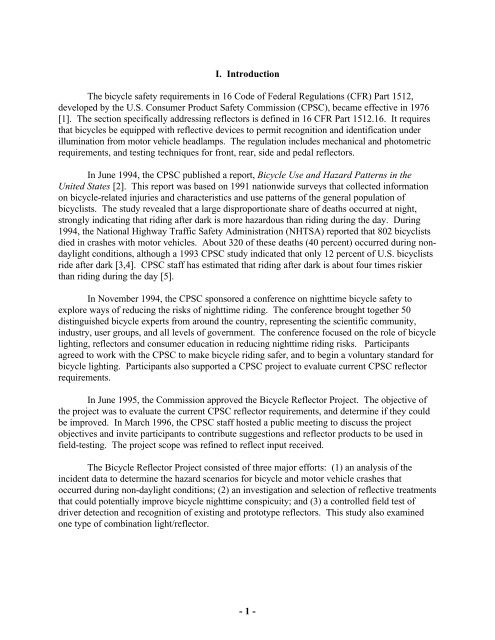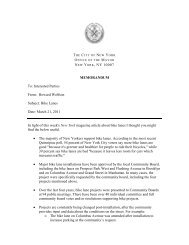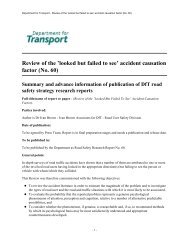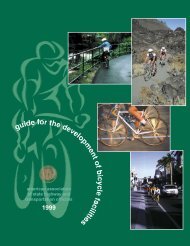Bicycle Reflector Project - Consumer Product Safety Commission
Bicycle Reflector Project - Consumer Product Safety Commission
Bicycle Reflector Project - Consumer Product Safety Commission
You also want an ePaper? Increase the reach of your titles
YUMPU automatically turns print PDFs into web optimized ePapers that Google loves.
I. Introduction<br />
The bicycle safety requirements in 16 Code of Federal Regulations (CFR) Part 1512,<br />
developed by the U.S. <strong>Consumer</strong> <strong>Product</strong> <strong>Safety</strong> <strong>Commission</strong> (CPSC), became effective in 1976<br />
[1]. The section specifically addressing reflectors is defined in 16 CFR Part 1512.16. It requires<br />
that bicycles be equipped with reflective devices to permit recognition and identification under<br />
illumination from motor vehicle headlamps. The regulation includes mechanical and photometric<br />
requirements, and testing techniques for front, rear, side and pedal reflectors.<br />
In June 1994, the CPSC published a report, <strong>Bicycle</strong> Use and Hazard Patterns in the<br />
United States [2]. This report was based on 1991 nationwide surveys that collected information<br />
on bicycle-related injuries and characteristics and use patterns of the general population of<br />
bicyclists. The study revealed that a large disproportionate share of deaths occurred at night,<br />
strongly indicating that riding after dark is more hazardous than riding during the day. During<br />
1994, the National Highway Traffic <strong>Safety</strong> Administration (NHTSA) reported that 802 bicyclists<br />
died in crashes with motor vehicles. About 320 of these deaths (40 percent) occurred during nondaylight<br />
conditions, although a 1993 CPSC study indicated that only 12 percent of U.S. bicyclists<br />
ride after dark [3,4]. CPSC staff has estimated that riding after dark is about four times riskier<br />
than riding during the day [5].<br />
In November 1994, the CPSC sponsored a conference on nighttime bicycle safety to<br />
explore ways of reducing the risks of nighttime riding. The conference brought together 50<br />
distinguished bicycle experts from around the country, representing the scientific community,<br />
industry, user groups, and all levels of government. The conference focused on the role of bicycle<br />
lighting, reflectors and consumer education in reducing nighttime riding risks. Participants<br />
agreed to work with the CPSC to make bicycle riding safer, and to begin a voluntary standard for<br />
bicycle lighting. Participants also supported a CPSC project to evaluate current CPSC reflector<br />
requirements.<br />
In June 1995, the <strong>Commission</strong> approved the <strong>Bicycle</strong> <strong>Reflector</strong> <strong>Project</strong>. The objective of<br />
the project was to evaluate the current CPSC reflector requirements, and determine if they could<br />
be improved. In March 1996, the CPSC staff hosted a public meeting to discuss the project<br />
objectives and invite participants to contribute suggestions and reflector products to be used in<br />
field-testing. The project scope was refined to reflect input received.<br />
The <strong>Bicycle</strong> <strong>Reflector</strong> <strong>Project</strong> consisted of three major efforts: (1) an analysis of the<br />
incident data to determine the hazard scenarios for bicycle and motor vehicle crashes that<br />
occurred during non-daylight conditions; (2) an investigation and selection of reflective treatments<br />
that could potentially improve bicycle nighttime conspicuity; and (3) a controlled field test of<br />
driver detection and recognition of existing and prototype reflectors. This study also examined<br />
one type of combination light/reflector.<br />
- 1 -





